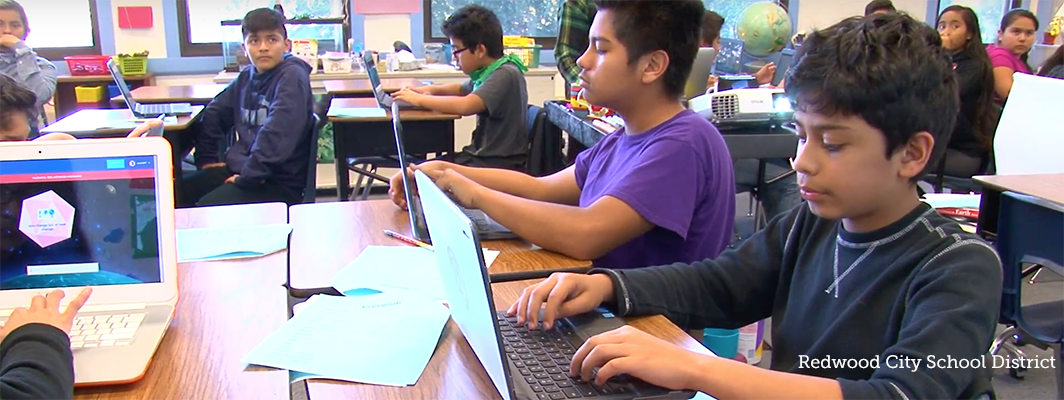
October 2, 2017 | By Kathryn Marinos
We have made great strides to level the technology playing field in education, but unfortunately the digital divide still exists between those who have the tools to research, learn and collaborate online at home, and those who don’t.1 Further, there’s a second level digital divide2 that’s emerging in the classroom. The gap is growing between students who are only exposed to technology for uses such as test prep and reading static online content and students leveraging technology to work out exciting and relevant problems, conduct deep research, connect with peers around the world and access experts.
A great example of how one school in Silicon Valley is supporting powerful use of technology3 in the classroom is in Redwood City School District (RCSD). Thanks to the generous support of the Chan Zuckerberg Initiative, Digital Promise and RCSD’s McKinley Institute of Technology (MIT) have been working on a one-to-one Literacy Initiative to support powerful use of technology for learning and address the second level digital divide.
The program began in March 2016 at MIT, a comprehensive middle school with 6th, 7th and 8th grades. Digital Promise and MIT provided instruction and learning opportunities across all curriculum areas to promote powerful language and literacy, and skills of inquiry, collaboration and teamwork. Key components of the one-to-one Literacy Initiative include:
Real change requires supportive professional development. As part of the Literacy Initiative, teachers piloted creation and exploration apps, as well as both Hapara and Google Classroom to refine their workflow processes. Throughout the year, teachers developed and refined strategies to address the needs of ALL of their students, and spark students’ creativity through effective use of technology for learning. Instruction was driven by data-rich, strategic and reflective practices using online formative assessments such as Newsela quizzes, STAR Reading and district-aligned Edulastic assessments.
The Initiative’s focus on community building had a major positive impact on the program’s success. The Literacy initiative touched all aspects of the school community, especially family education.
Preliminary data suggest that the program is already contributing to the literacy development of students.
It takes a village to support our students and the one-to-one Literacy Initiative is a great example of what can be accomplished if new technology programs are supported by school leadership, teachers receive the training they need, and students and parents are involved and engaged from the beginning. If you are interested in learning more, or bringing a similar program to your school or district, contact: Digital Promise Professional Services at professionalservices@digitalpromise.org.
Citations
[1] “Closing the Digital Learning Gap – Digital Promise.” https://digitalpromise.org/2014/04/28/closing-the-digital-learning-gap/. Accessed 2 Oct. 2017.
[2] “Second-Level Digital Divide: Differences in People’s … – First Monday.” https://firstmonday.org/article/view/942/864. Accessed 29 Sep. 2017.
[3] “leveraging technology to solve complex problems, work with big data sets, connect across borders, access experts, collaborate with peers, and engage in compelling projects. These learning scenarios support the development of skills such as critical thinking, inquiry and research, creativity, problem solving, designing and collaboration. They help students develop a sense of agency, the ability to harness technology, and support learning lifelong and lifewide. However, in other scenarios, students are engaged with lower-level uses of technology such as test preparation, reading static online content, and seemingly endless drill and practice exercises.” https://digitalpromise.org/2017/07/26/addressing-the-digital-learning-gap-with-effective-educator-coaching/
[4] Source: https://caaspp.cde.ca.gov/
By Elliott Barnes and Sara Mungall